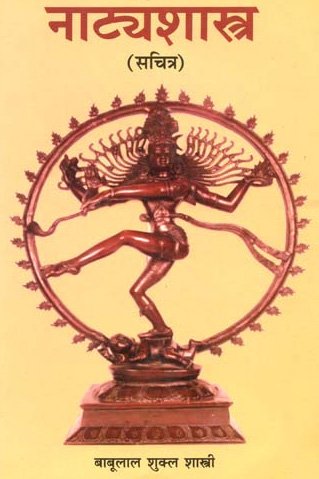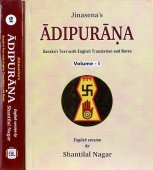Mahakavya, Mahākāvya, Maha-kavya: 13 definitions
Introduction:
Mahakavya means something in Hinduism, Sanskrit, Marathi. If you want to know the exact meaning, history, etymology or English translation of this term then check out the descriptions on this page. Add your comment or reference to a book if you want to contribute to this summary article.
In Hinduism
Kavyashastra (science of poetry)
Source: Shodhganga: Bhismacaritam a critical studyMahākāvya (महाकाव्य) is a poetical work of sizeable length written mainly in narrative style. Epic poetry, as distinguished from lyrical, is characterized by the fact that it confines itself more to external action than to internal feelings. As the nation grows up in ideas and civilization, and naturally begins to reason and to speculate, its mind turns inward, putting a stop to the spontaneous outburst of epic, the natural expression of national life.
Mahākāvya is usually divided into cantos (sargas). It is to be written in pure Sanskrit and in no other dialect. Some historical incidents or some characters of celebrity should form the theme of a mahākāvyam or some supernatural events might be as well immortalized in its pages. Such political incidents, as councils of state, sending of embassies, as well as the marching out of soldiers in battle army, should be taken not to encumber its majesty with a dull monotony of detailed descriptions. The metres, to be used, in its composition, are the Śakvarī;, the Ati-Jagatī;, the Ati-Śakvarī;, the Triṣṭup and the Puṣpitāgrā;. The cantos shall deal with different incidents of the same story and they should not be too short or succinct. [...]
Cf. Mahākāvya in the Sāhityadarpaṇa, VI. 315-325

Kavyashastra (काव्यशास्त्र, kāvyaśāstra) refers to the ancient Indian tradition of poetry (kavya). Canonical literature (shastra) of the includes encyclopedic manuals dealing with prosody, rhetoric and various other guidelines serving to teach the poet how to compose literature.
Nirukta (Sanskrit etymology)
Source: Shodhganga: Bhismacaritam a critical study (etymology)Mahākāvya (महाकाव्य) is a composite of two words, (mahat) great and kāvya (poem), meaning a ‘great poem’. Mahākāvya is generally differentiated from rest of the kāvyas by its essence, i.e. by its subject matter and treatment.
Nirukta (निरुक्त) or “etymology” refers to the linguistic analysis of the Sanskrit language. This branch studies the interpretation of common and ancient words and explains them in their proper context. Nirukta is one of the six additional sciences (vedanga) to be studied along with the Vedas.
Languages of India and abroad
Marathi-English dictionary
Source: DDSA: The Molesworth Marathi and English Dictionarymahākāvya (महाकाव्य).—n (S) A regular and classical poem. Applied, par excellence, to each of six great works.
Marathi is an Indo-European language having over 70 million native speakers people in (predominantly) Maharashtra India. Marathi, like many other Indo-Aryan languages, evolved from early forms of Prakrit, which itself is a subset of Sanskrit, one of the most ancient languages of the world.
Sanskrit dictionary
Source: DDSA: The practical Sanskrit-English dictionaryMahākāvya (महाकाव्य).—a great or classical poem; (for a full description of its nature, contents &c., according to Rhetoricians see S. D.559). (The number of Mahākāvyas is usually said to be five:-raghuvaṃśa, kumārasaṃbhava, kirātārjunīya, śiśupālavadha and naiṣadhacarita or six, if meghadūta-a very small poem or khaṇḍakāvya-be added to the list. But this enumeration is apparently only traditional, as there are several other poems, such as the bhaṭṭikāvya, vikramāṅkadevacarita, haravijaya &c. which have an equal claim to be considered as Mahākāvyas).
Derivable forms: mahākāvyam (महाकाव्यम्).
Mahākāvya is a Sanskrit compound consisting of the terms mahā and kāvya (काव्य).
Source: Cologne Digital Sanskrit Dictionaries: Shabda-Sagara Sanskrit-English DictionaryMahākāvya (महाकाव्य).—n.
(-vyaṃ) A regular and classical poem. E. mahā great, and kāvya a poem; the title is applied especially to five works; the Kumara Sambhava, and Raghu Vansa of Kalidasa; the Kiratarjuniya of Bharabi; the Naisadha of Sriharsha, and the Sisupala Badham of Magha.
Source: Cologne Digital Sanskrit Dictionaries: Benfey Sanskrit-English DictionaryMahākāvya (महाकाव्य).—n. a classical poem,
Mahākāvya is a Sanskrit compound consisting of the terms mahā and kāvya (काव्य).
Source: Cologne Digital Sanskrit Dictionaries: Cappeller Sanskrit-English DictionaryMahākāvya (महाकाव्य).—[neuter] great or classical poem.
Source: Cologne Digital Sanskrit Dictionaries: Monier-Williams Sanskrit-English DictionaryMahākāvya (महाकाव्य):—[=mahā-kāvya] [from mahā > mah] n. a great or classical poem (applied as a distinguishing title to 6 chief artificial poems, viz. the Raghu-vaṃśa, Kumārasambhava and Megha-dūta by Kālidāsa, the Śiśupāla-vadha by Māgha, the Kirātārjunīya by Bhāravi and the Naiṣadha-carita by Śrī-harṣa; [according to] to some the Bhaṭṭi-kāvya is also a M°), [Kāvyādarśa; Pratāparudrīya] ([Indian Wisdom, by Sir M. Monier-Williams 452]).
Source: Cologne Digital Sanskrit Dictionaries: Yates Sanskrit-English DictionaryMahākāvya (महाकाव्य):—[mahā+kāvya] (vyaṃ) 1. n. A regular and classical epic poem.
[Sanskrit to German]
Sanskrit, also spelled संस्कृतम् (saṃskṛtam), is an ancient language of India commonly seen as the grandmother of the Indo-European language family (even English!). Closely allied with Prakrit and Pali, Sanskrit is more exhaustive in both grammar and terms and has the most extensive collection of literature in the world, greatly surpassing its sister-languages Greek and Latin.
Kannada-English dictionary
Source: Alar: Kannada-English corpusMahākāvya (ಮಹಾಕಾವ್ಯ):—[noun] a long narrative poem in a dignified style about the noble deeds of a traditional or historical hero or heroes,with certain formal characteristics ; an epic.
Kannada is a Dravidian language (as opposed to the Indo-European language family) mainly spoken in the southwestern region of India.
Nepali dictionary
Source: unoes: Nepali-English DictionaryMahākāvya (महाकाव्य):—n. an epic; a great poem; conventional designation of a single poetical work of large scope and formal style;
Nepali is the primary language of the Nepalese people counting almost 20 million native speakers. The country of Nepal is situated in the Himalaya mountain range to the north of India.
See also (Relevant definitions)
Ends with: Balabharatamahakavya, Caitanyacaritamahakavya, Chaitanyacharitamahakavya, Durgavilasamahakavya, Hammiramahakavya, Padmanandamahakavya, Rajaprashastimahakavya, Rasasundaramahakavya, Shashivamshamahakavya, Tattvabodhamahakavya.
Full-text (+241): Sargabandha, Suktaratnakara, Hammiracarita, Mahakavi, Bharavi, Patalavijaya, Mahananda, Jambavatijaya, Svargarohana, Yamapala, Raghuvamsha, Rasasundaramahakavya, Rasabdhi, Rasasundara, Sausthyena, Vastu, Raghunathabhyudaya, Rajaprashastimahakavya, Arjunacarita, Rukmangadiya.
Relevant text
Search found 35 books and stories containing Mahakavya, Mahākāvya, Maha-kavya, Mahā-kāvya; (plurals include: Mahakavyas, Mahākāvyas, kavyas, kāvyas). You can also click to the full overview containing English textual excerpts. Below are direct links for the most relevant articles:
Kuntaka’s evaluation of Sanskrit literature (by Nikitha. M)
Introduction < [Chapter 3 - Kuntaka’s estimation of Mahākāvyas of other Poets]
3. Harivijaya in Kuntaka’s treatment < [Chapter 3 - Kuntaka’s estimation of Mahākāvyas of other Poets]
Conclusion to Chapter 3 < [Chapter 3 - Kuntaka’s estimation of Mahākāvyas of other Poets]
Vasudevavijaya of Vasudeva (Study) (by Sajitha. A)
Is Vāsudevavijaya a Mahākāvya? < [Chapter 4 - Vāsudevavijaya—A Literary Appreciation]
Rāmavarmamahārājacaritra of Vaikkath Pāccu Mūttatu < [Chapter 1 - Śāstrakāvyas—A Brief Survey]
Shishupala-vadha (Study) (by Shila Chakraborty)
Śiśupālavadha is an epic < [Introduction]
Knowledge of Arthaśāstra in the Śiśupālavadha < [Introduction]
Date of the poet Māgha < [Introduction]
Annadatri-carita (study) (by Sarannya V.)
1. The Author and works < [Chapter 3 - An Introduction to Annadatri-carita]
3. Representation of Uthiyan Cheralathan in History < [Chapter 2 - Depiction of King Utiyan Ceralatan in History and Literature]
7. The Grand feast in Sanskrit Literature < [Chapter 1 - The Myth of Grand Feast]
The backdrop of the Srikanthacarita and the Mankhakosa (by Dhrubajit Sarma)
Part 3 - Mahākāvya and its features < [Chapter I - Introduction]
Part 4 - Sanskrit mahākāvyas < [Chapter I - Introduction]
Sanskrit sources of Kerala history (by Suma Parappattoli)
14. Nayakabharana or Astalayanayakiya < [Chapter 3 - Historical Details from Mahakavyas]
15. Other Mahakavyas describing Kerala < [Chapter 3 - Historical Details from Mahakavyas]
11. Sri Narayana Vijayam of Balarama Panickar < [Chapter 3 - Historical Details from Mahakavyas]
Related products
